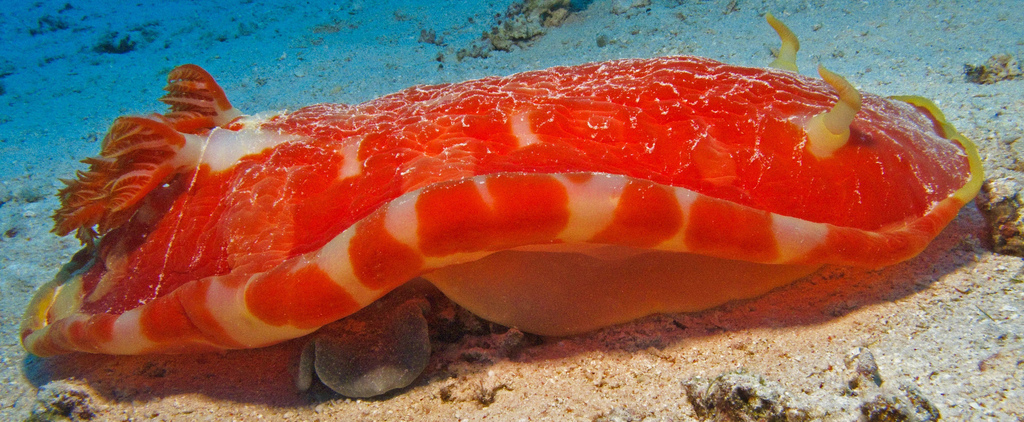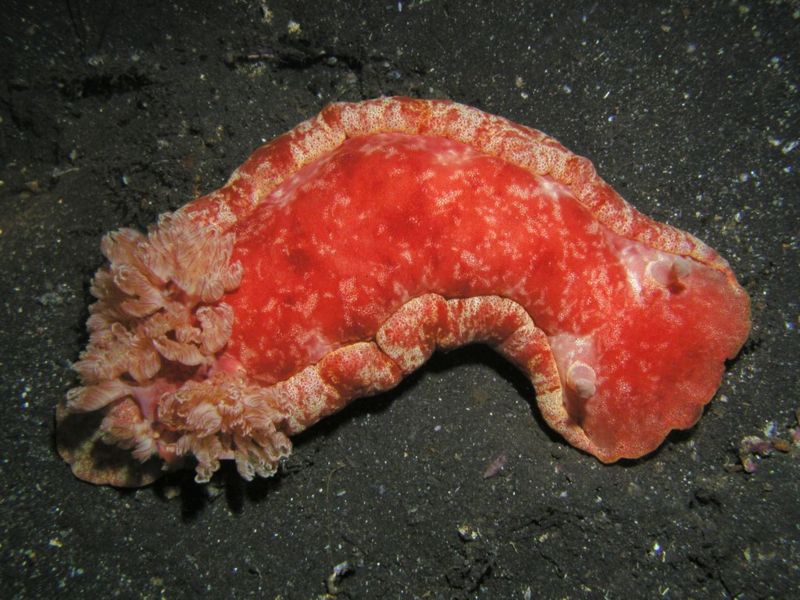Classification
Kingdom- Animalia
Phylum- Mollusca
Class- Gastropoda
Order- Nudibranchia
Family- Hexabranchidae
Genus- Hexabranchus
Species- Hexabranchus sanguineus
Domain – Eukarya: The Spanish Dancer is made up of eukaryotic
cells which contain membrane bound organelles and a true
nucleus, allowing it to fall under the category of eukarya. To
learn about another intersting organism in this domain check out the
Mantis Shrimp or the
Tiger Flatworm!
Kingdom – Animalia: Animals are eukaryotic, multicellular
organisms. They lack structural walls (cell wall which we see in
plants) and are heterotrophic, meaning they must have some way
of obtaining food since they cannot produce their own food like
plants. Animals also require oxygen and are motile at some stage
in their life. The Spanish Dancer belongs to the eukarya domain,
meaning it is eukaryotic, and is also heterotropic as it is a
carnivore and eats coral, sponges, and even other nudibranchs.
Along with this, the Spanish Dancer is known for its mobility in
the way that it swims. Interestingly enough, they are the only
species of nudibranch that can swim. Other organisms that belong
to this kindom are the
Snow Crab and
Japanese Puffer Fish.
Phylum – Mollusca: Members of the phylum Mollusca have a soft
body that is usually protected by a shell (exoskeleton). They
have a heart, digestive system, and nervous system. Other
organisms in this category include snails such as the
Dryland Liptooth, the
Giant Pacific Octopus, the
Humbolt Squid,
clams, and oysters.
Class – Gastropoda: Gastorpod means “stomach foot” which
describes the way the body and internal organs are arranged.
Most organisms of the gastropoda class are hermaphrodites which
means that they contain both male and female reproductive
organs. This is true for the Spanish Dancer. Gastropods also use
a radula to feed. A radula is a toungue-like structure that
contains rows of teeth. Gastropods also have a head with
eyes and one or two pairs of tentacles. In the case of the
Spanish Dancer, these tentacles are called rhinophores. Another
cool example of an organism in this class is the
Cinnamon Covert, the
Upland Pillsnail, and the
Whitelip Snail.
Order – Nudibranchia: This class contains numerous gastropod
mollusks that lack a shell and have a soft body.
Family – Hexabranchidae:
monotypic family of nudibranchs, or sea slugs, that are considered dorid
and contain a single genus Hexabranchus.
Genus – Hexabranchus:
This genus contains nudibranchs that appear redish-pink in colorand even
yellow in rare form. They are also capable of swimming.
Species – Hexabranchus sanguineus: Here we have the Spanish
Dancer nudibranch! Hexabranchus sanguineus translates
to “blood colored six-gills.” This represents the six red colored gills
of the nudibranch which are always exposed, or “naked."

Figure 1. Phylogeny of the animal phylums. This phylogeny was created by
Devin Yurk.
This phylogeny shows where nudibranch place in the animal phylum. Following the red line leads you to the mollusca phylum where nudibranchs are categorized and from this we can see that they are close relatives to the annelida phylum.
The phylogeny below represents different spicule arrangement and characteristics among different species of nudibranchs. As we can see, the Hexabranchus sanguineus is most closely related to Bathydoris aioca, which share the common characteristics of absent spicules (Penney, 2008).

Figure 2. Phylogeny of spicule network characters. Higher taxa are based on that manuscript. Chromo. = Chromodorididae, Dorid. = Dorididae, Disco. = Discodorididae, Dendro. = Dendrodorididae, Phyll. = Phyllidiidae. Dashed line indicates division between the caryophyllid-bearing dorids and other Discodorididae. Missing boxes indicate characters not applicable to that species, ? = missing information. Characters are listed 1 to 5 vertically, as follows: 1. Spicule presence: 0 = present, 1 = absent. 2. Mantle edge network form: 0 = no network, 1 = dendritic, 2 = cobweb-like, 3 = lattice. 3. Central notum network: 0 = same as mantle edge, 1 = absent, 2 = large spicules. 4. Papillae support: 0 = no spicules, 1 = disorganized rosette, 2 = spicule ring, 3 = rods of large spicules. 5. Foot edge network form: 0 = no network, 1 = dendritic, 2 = cobweb-like, 3 = lattice. This pylogeny was created by Angel Valdes.

